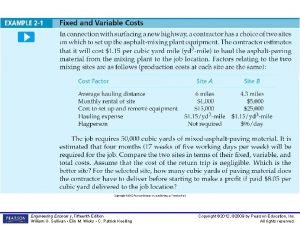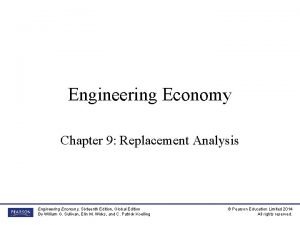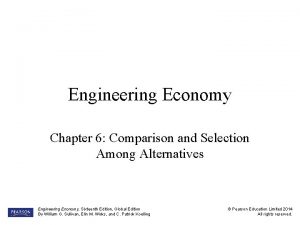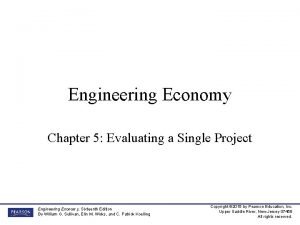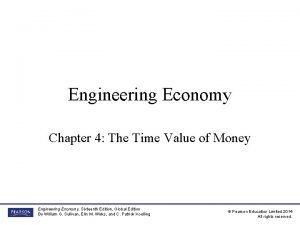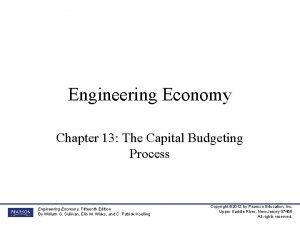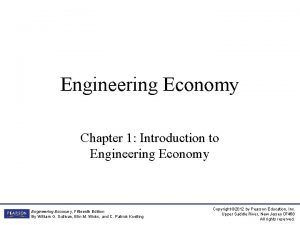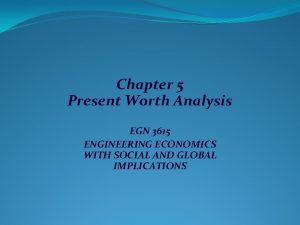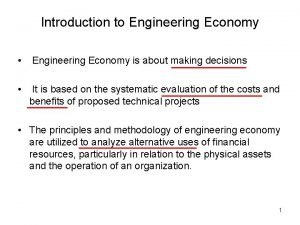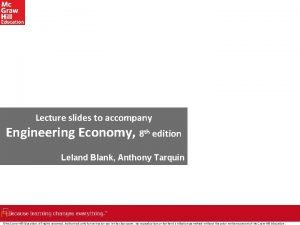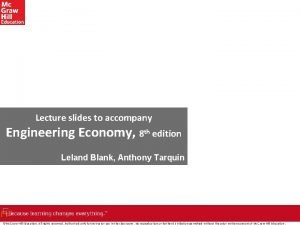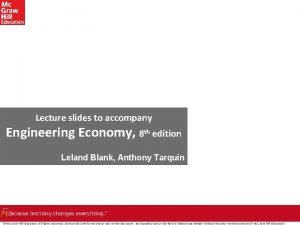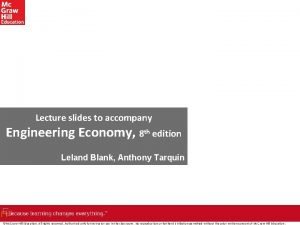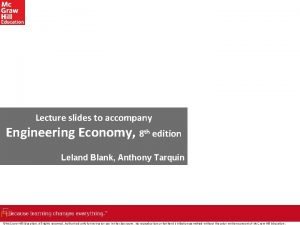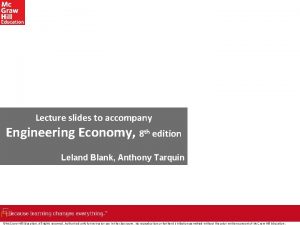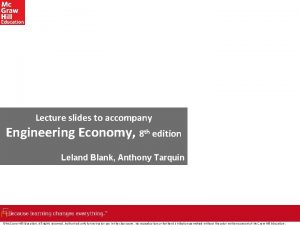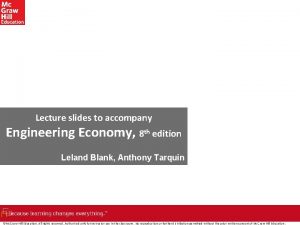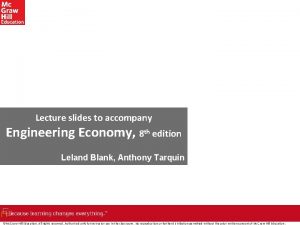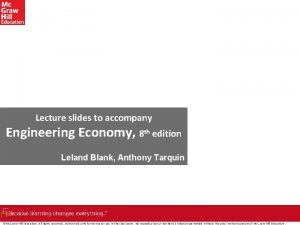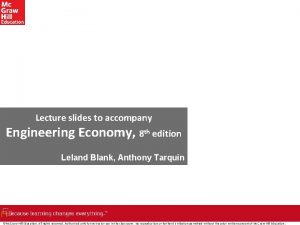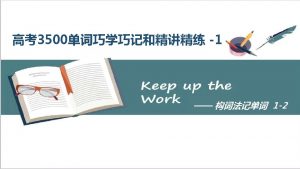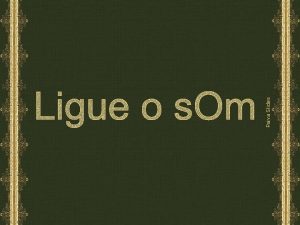Lecture slides to accompany Engineering Economy 8 th




















- Slides: 20

Lecture slides to accompany Engineering Economy, 8 th edition Leland Blank, Anthony Tarquin ©Mc. Graw-Hill Education. All rights reserved. Authorized only for instructor use in the classroom. No reproduction or further distribution permitted without the prior written consent of Mc. Graw-Hill Education.

Chapter 7 Rate of Return One Project ©Mc. Graw-Hill Education. All rights reserved. Authorized only for instructor use in the classroom. No reproduction or further distribution permitted without the prior written consent of Mc. Graw-Hill Education.

LEARNING OUTCOMES 1. Understand meaning of ROR 2. Calculate ROR for cash flow series 3. Understand difficulties of ROR 4. Determine multiple ROR values 5. Calculate External ROR (EROR) 6. Calculate r and i for bonds ©Mc. Graw-Hill Education.

Interpretation of ROR Rate paid on unrecovered balance of borrowed money such that final payment brings balance to exactly zero with interest considered ROR equation can be written in terms of PW, AW, or FW Use trial and error solution by factor or spreadsheet • ©Mc. Graw-Hill Education.

ROR Calculation and Project Evaluation • • ©Mc. Graw-Hill Education.

Finding ROR by Spreadsheet Function • • • ©Mc. Graw-Hill Education.

ROR Calculation Using PW, FW or AW Relation ROR is the unique i* rate at which a PW, FW, or AW relation equals exactly 0 Example: An investment of $20, 000 in new equipment will generate income of $7000 per year for 3 years, at which time the machine can be sold for an estimated $8000. If the company’s MARR is 15% per year, should it buy the machine? • • ©Mc. Graw-Hill Education.

Special Considerations for ROR May get multiple i* values (discussed later) i* assumes reinvestment of positive cash flows earn at i* rate (may be unrealistic) Incremental analysis necessary for multiple alternative evaluations (discussed later) ©Mc. Graw-Hill Education.

Multiple ROR Values Multiple i* values may exist when there is more than one sign change in net cash flow (CF) series. Such CF series are called non-conventional Two tests for multiple i* values: • Norstrom’s criterion: if the cumulative cash flow starts off negatively and has only one sign change, there is only one positive root. ©Mc. Graw-Hill Education.

Plot of PW for CF Series with Multiple ROR Values Year Cash Flow ($1000) Sequence Number Cumulative Cash Flow ($1000) 0 +2000 S 0 +2000 1 – 500 S 1 +1500 2 – 8100 S 2 – 6600 3 +6800 S 3 +200 i* values at ~8% and ~41% ©Mc. Graw-Hill Education.

Example: Multiple i* Values Determine the maximum number of i* values for the cash flow shown below Year 0 Expense Income Net cash flow Cumulative CF n/a 1 2 3 4 5 Solution: The sign on the net cash flow changes twice, indicating two possible i* values • ©Mc. Graw-Hill Education. The cumulative cash flow begins negatively with one sign change

Removing Multiple i* Values Two new interest rates to consider: • Investment rate ii – rate at which extra funds are invested external to the project • Borrowing rate ib – rate at which funds are borrowed from an external source to provide funds to the project Two approaches to determine External ROR (EROR) • (1) Modified ROR (MIRR) • (2) Return on Invested Capital (ROIC) ©Mc. Graw-Hill Education.

Modified ROR Approach (MIRR) • ©Mc. Graw-Hill Education.

Example: EROR Using MIRR Method • • ©Mc. Graw-Hill Education.

Return on Invested Capital Approach Measure of how effectively project uses funds that remain internal to project ROIC rate, i’’, is determined using net-investment procedure Three step Procedure • ©Mc. Graw-Hill Education.

ROIC Example • • ©Mc. Graw-Hill Education.

Important Points to Remember About the computation of an EROR values are dependent upon the selected investment and/or borrowing rates Commonly, multiple i* rates, i’ from MIRR and i’’ from ROIC have different values About the method used to decide For a definitive economic decision, set the MARR value and use the PW or AW method to determine economic viability of the project ©Mc. Graw-Hill Education.

Bond Investment • Face value is the money amount the bond will be worth at maturity; it is also the reference amount the bond issuer uses when calculating interest payments. For example, say an investor purchases a bond at a premium $1, 090 and another investor buys the same bond later when it is trading at a discount for $980. When the bond matures, both investors will receive the $1, 000 face value of the bond. • The coupon rate is the rate of interest the bond issuer will pay on the face value of the bond, expressed as a percentage. For example, a 5% coupon rate means that bondholders will receive 5% x $1000 face value = $50 every year. • Coupon dates are the dates on which the bond issuer will make interest payments. Payments can be made in any interval, but the standard is semiannual payments. • The maturity date is the date on which the bond will mature and the bond issuer will pay the bondholder the face value of the bond. ©Mc. Graw-Hill Education.

ROR of Bond Investment • A $10, 000 bond with 6% interest payable quarterly is purchased for $8000. If the bond matures in 5 years, what is the ROR (a) per quarter, (b) per year? • ©Mc. Graw-Hill Education.

Summary of Important Points • ©Mc. Graw-Hill Education.
 Things that belong to salvation
Things that belong to salvation Accompany chapter 1
Accompany chapter 1 Lymphatic drainage of upper limb
Lymphatic drainage of upper limb Printers create objects such as prototypes and models.
Printers create objects such as prototypes and models. Athens and sparta were both
Athens and sparta were both A small child slides down the four frictionless slides
A small child slides down the four frictionless slides Change in energy quick check
Change in energy quick check Principles of economics powerpoint lecture slides
Principles of economics powerpoint lecture slides Introduction to machine learning ethem alpaydın
Introduction to machine learning ethem alpaydın Business communication lecture slides
Business communication lecture slides 01:640:244 lecture notes - lecture 15: plat, idah, farad
01:640:244 lecture notes - lecture 15: plat, idah, farad Engineering economy
Engineering economy Engineering economy 15th edition
Engineering economy 15th edition Engineering economy
Engineering economy Comparison and selection among alternatives
Comparison and selection among alternatives Engineering economy 16th edition solution manual chapter 5
Engineering economy 16th edition solution manual chapter 5 Engineering economy 16th edition chapter 4 solutions
Engineering economy 16th edition chapter 4 solutions Engineering economy
Engineering economy Engineering economy 15th edition
Engineering economy 15th edition Present worth analysis
Present worth analysis Introduction to engineering economy
Introduction to engineering economy












